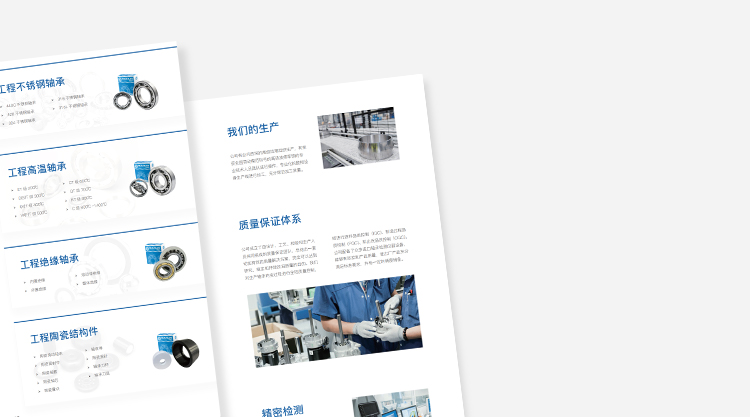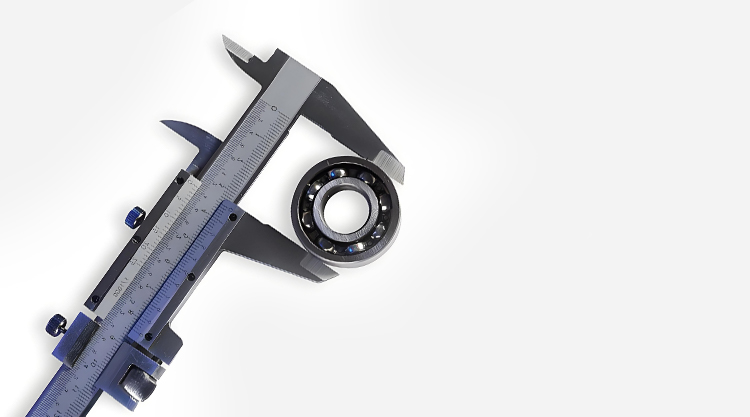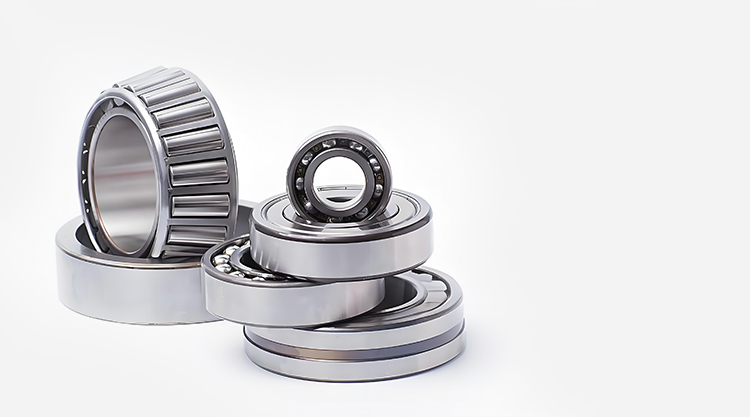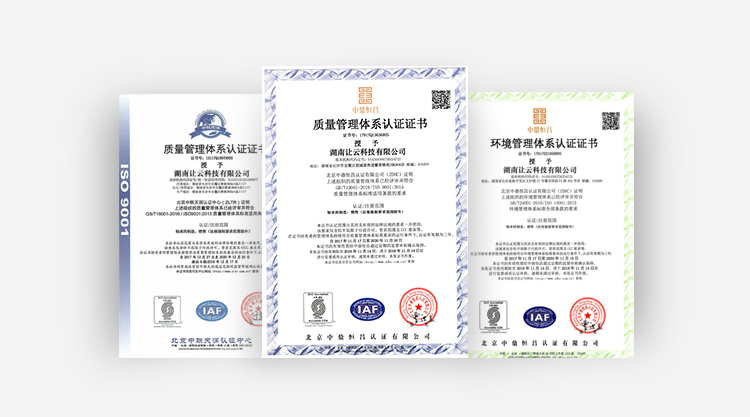Characteristics and Types of Different Bearings
In fields such as industrial machinery, automotive manufacturing, and home appliance production, bearings, as key transmission components, directly affect the operation precision and lifespan of equipment. Understanding the structural differences of different types of bearings and mastering the characteristics of each type is the core premise for engineers and procurement personnel to make precise selections.
1. Two Core Classifications of Bearings: Rolling Bearings and Sliding Bearings
From the perspective of friction, bearings are mainly divided into two categories: rolling bearings and sliding bearings. These two differ significantly in structure, friction coefficient, and applicable scenarios, which serve as the basic criteria for distinguishing between bearing types.
1.1 Rolling Bearings: The Most Widely Used Type in Industrial Applications
Rolling bearings achieve indirect contact between the shaft and the housing through rolling elements (such as steel balls and rollers). With a low friction coefficient and low starting resistance, they are currently the most commonly used bearing type in industrial equipment. Their core features include:
Low friction coefficient (typically between 0.001 and 0.005), enabling smoother startup and lower energy consumption;
High standardization and strong interchangeability, making procurement and maintenance costs manageable;
Able to simultaneously bear radial or axial loads (depending on the specific type), suitable for a wide range of applications.
1.2 Sliding Bearings: The Preferred Choice for High Load, Low-Speed Applications
Sliding bearings transmit power through direct sliding contact between the shaft neck and bearing shell, with no rolling elements. Their characteristics make them more suitable for high-load applications:
Strong bearing capacity, capable of withstanding radial or axial loads ranging from hundreds to thousands of kilonewtons;
Compact structure with a small radial size, suitable for space-constrained equipment (such as large motors and rolling mills);
Stable operation with low vibration and noise, but a higher friction coefficient (typically between 0.01 and 0.1), requiring regular lubrication.
2. Main Types of Rolling Bearings and Their Characteristics: The Key to Precise Selection
Rolling bearings are the "workhorse" of the industrial field. Based on the shape of the rolling elements and the direction of the load, they can be subdivided into various types. The characteristics of each bearing type determine its suitability for different applications.
| Deep Groove Ball Bearings: The Most Versatile Basic Type | Simple structure consisting of an inner ring, outer ring, steel balls, and a cage. Low manufacturing cost; Can simultaneously bear radial loads and light axial loads, suitable for most general machinery; Wide speed range (up to tens of thousands of RPM), commonly found in motors, water pumps, and household appliances. |
|---|---|
| Cylindrical Roller Bearings: The First Choice for High Radial Load Applications | Radial load capacity much higher than that of deep groove ball bearings, suitable for heavy radial load applications (such as machine tool spindles and cranes); The inner and outer rings are separable, offering high installation flexibility and ease of maintenance; Low friction coefficient and excellent speed performance, but cannot bear axial loads and must be used in combination with other bearings. |
| Angular Contact Ball Bearings: Dual Adaptation for Axial and Radial Loads | The greater the contact angle, the stronger the axial load capacity (40° contact angle is suitable for high axial load applications); Typically used in pairs (face-to-face or back-to-back installation) to ensure the precision of the equipment, commonly found in precision machine tools and automotive gearboxes; Better speed performance, but the structure is more complex than deep groove ball bearings, and the cost is slightly higher. |
| Tapered Roller Bearings: The "Heavy Duty" Choice for High Load Equipment | Capable of simultaneously bearing large radial and axial loads with high load-bearing efficiency; Speed performance is slightly inferior to angular contact ball bearings, but more suitable for heavy load applications (such as automotive rear axles and construction machinery wheels); Installation requires adjusting the clearance to ensure bearing stability and prevent overheating and damage. |
| Thrust Bearings: Specialized for Pure Axial Loads | Thrust ball bearings: Simple structure, suitable for light load and high-speed axial applications (such as machine tool lead screws); Thrust roller bearings (such as thrust cylindrical roller bearings and thrust spherical roller bearings): Strong bearing capacity, suitable for heavy axial load applications (such as hydraulic presses and large gearboxes); Small radial size but cannot bear radial loads, and must be used in combination with radial bearings. |
3. Key Factors for Bearing Selection: Matching Bearing Types and Characteristics to Applications
After understanding the different bearing types and their characteristics, selection should be based on the actual working conditions of the equipment, focusing on the following three dimensions:
| Load Type | For radial load only, select deep groove ball bearings or cylindrical roller bearings; for both axial and radial loads, select angular contact ball bearings or tapered roller bearings; for pure axial loads, select thrust bearings. |
|---|---|
| Speed Requirements | For high-speed applications (such as motors and precision machine tools), prioritize deep groove ball bearings or angular contact ball bearings; for low-speed, heavy-load applications (such as rolling mills and cranes), select sliding bearings or tapered roller bearings. |
| Operating Environment | In dusty or humid environments, select bearings with good sealing performance (such as deep groove ball bearings with dust covers); for high-temperature environments, select bearings made of heat-resistant materials (such as ceramic rolling element bearings). |
4. Conclusion
The type and characteristics of bearings directly determine the operating efficiency and lifespan of equipment. Whether it's the general-purpose deep groove ball bearings or the heavy-duty tapered roller bearings, accurately matching the application conditions is the key to selection. Professionals in the industrial field must fully understand the structural differences between bearing types and select products based on their characteristics and actual needs to maximize equipment value. As industrial equipment moves toward higher precision and higher speeds, the performance requirements for bearings will further increase, making an understanding of their classification and characteristics an essential skill for the industry.
-
30 2025.10High-Speed Equipment Bearing Selection Guide
This paper systematically analyzes the selection logic for high-speed bearings and provides actionable technical solutions tailored to industrial application scenarios.
-
30 2025.10Guide to Material Selection and Purchase of Rubber-Lined Bearings
This article will provide an in-depth analysis of the material properties and selection strategies for rubber-coated components, helping enterprises precisely match their equipment requirements.
-
30 2025.10Bearing Speed: Influencing Factors, Calculation Methods, and Speed Ranges for Differe
This article will explore the factors influencing bearing rotational speed, calculation methods, common bearing speed ranges, and usage precautions, providing practical guidance for professionals in t
-
30 2025.10Eccentric Bearings: The “Eccentric Adjustment Experts” in Industrial Machinery
In industrial mechanical transmission systems, eccentric bearings serve as critical components for achieving shaft eccentricity adjustment and compensating for installation errors.




